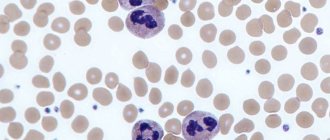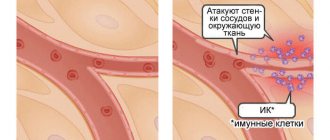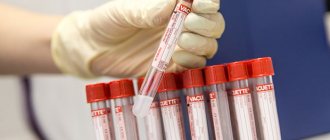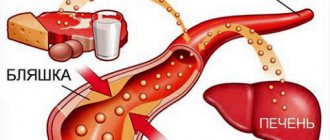This organic fat-like substance performs many important functions. Without it, the synthesis of hormones, the absorption of most vitamins, the formation of bile acids, and hematopoiesis are impossible. Most of the cholesterol is produced inside the body, about 20% comes from the outside, with food. An increase in the level of this compound is fraught with the development of atherosclerosis and other diseases. Excess cholesterol fills the lumen of blood vessels and settles in the gallbladder in the form of stones.
Reasons for increased and decreased indicators
If there is a significant deviation from the TG norms, this indicates metabolic disorders and the development of diseases of various types. Increased content may have the following reasons:
- diseases of the cardiovascular system (ischemia, hypertension, atherosclerosis);
- disruptions in the functioning of the nervous system;
- gout;
- decreased thyroid function;
- obesity, chronic alcoholism;
- increased sugar levels;
- glucose absorption disorders;
- renal failure.
Systematically elevated TG levels (without proper treatment) can be fraught with the development of diabetes mellitus, atherosclerosis, and myocardial infarction. In such a situation, cholesterol and blood sugar should also be controlled.
Elevated levels of triglycerides in the blood can trigger the development of diabetes.
Low values are less common. When studies have confirmed reduced levels, the following pathologies can be suspected:
- chronic forms of lung diseases;
- hyperfunction of the thyroid gland;
- poor nutrition;
- damage to kidney tissue;
- myasthenia gravis;
- ischemic stroke.
If abnormal triglyceride levels are detected during testing, action should be taken as soon as possible. If left untreated, the situation can get out of control.
What is good and bad cholesterol
In tissues and blood, cholesterol forms special complexes with groups of lipoprotein proteins. They ensure its stable suspended state. Some of them have high density, others low. These properties of lipoproteins determine the types of cholesterol:
- “good”: HDL, protects cells from damage, ensures normal blood flow and vascular elasticity;
- “bad”: LDL, prone to precipitation, forming atherosclerotic plaques.
It is low-density cholesterol that is meant when they talk about its harm to health. This is true, since its excess is directly related to cardiovascular diseases, diabetes, poor circulation and the risk of strokes. LDL promotes the accumulation of triglycerides - simple fatty acids, overloads the liver, and contributes to the development of gallstones. High-density cholesterol inhibits these pathological processes and partially neutralizes the effect of the “bad”.
Triglycerides and their values are normal by age: table
Normally, the level of triglycerides in the blood differs depending on age; men and women also have different levels (see table). After 50 years, it is necessary to focus on lower concentrations of fats in order to prevent the development of vascular diseases.
Based on the results of the primary preventive examination of adult patients, they are divided into risk groups:
- low – triglycerides up to 1.7 mmol/l;
- borderline – up to 2.2 mmol/l;
- high – up to 5.6 mmol/l;
- extremely high – more than 5.6 mmol/l.
The higher the risks, the greater the likelihood of developing atherosclerosis, the greater the risk of heart attack and stroke.
Features of hypertriglyceridemia in men
In men, elevated triglyceride levels quickly cause serious problems. And the older a man gets, the greater the likelihood of a dark development of the situation.
The fact is that increased TG in the plasma of the stronger half correlates with bad cholesterol, which causes an increase in cardiovascular pathologies, the formation of blood clots, cholesterol plaques with all the attendant risks.
And the reasons in most situations lie in the wrong lifestyle:
- smoking, alcohol addiction and everyday drunkenness;
- prolonged stress;
- excess flour and fatty foods in the diet against the background of a lack of protein foods;
- lack of physical activity;
- taking steroids and androgens to build muscle mass.
The last reason from the list is typical for bodybuilders and weightlifters. Like any hormones, lipids are involved in steroid metabolism. And the more an athlete uses anabolic steroids, the more dangerous the consequences.
Triglycerides are normal in women (table by age)
We bring to your attention a table: the norms of triglycerides (TAG / TG) in the blood of women (by age) / in girls and young women (i.e. in small children or adolescents). Units of measurement: mmol/l and mg/dl.
- What are triglycerides, normal levels, reasons for the increase, how to reduce
| AGE | (mmol/L) | (MG/DL) |
| up to 10 years | 0.41 – 1.25 | 36.3 – 110.6 |
| 10-15 | 0.42 – 1.49 | 37.2 – 131.9 |
| 15-20 | 0.41 – 1.54 | 36.3 – 136.3 |
| 20-25 | 0.42 – 1.49 | 37.2 – 131.9 |
| 25-30 | 0.43 – 1.64 | 38.0 – 145.1 |
| 30-35 | 0.45 – 1.71 | 39.8 – 151.3 |
| 35-40 | 0.46 – 2.00 | 40.7 – 177.0 |
| 40-45 | 0.52 – 2.17 | 46.0 – 192.0 |
| 45-50 | 0.53 – 2.43 | 46.9 – 215.0 |
| 50-55 | 0.60 – 2.64 | 53.1 – 233.6 |
| 55-60 | 0.63 – 2.97 | 55.7 – 262.8 |
| 60-65 | 0.64 – 2.71 | 56.6 – 239.8 |
| 65-70 years | 0.69 – 2.72 | 61.0 – 240.7 |
Medicines designed to lower triglyceride levels
- Fibrates. Belong to carboxylic acids. The decrease in the indicator occurs due to the amphipathic function;
- A nicotinic acid. Acts in the same way as fibrates, but increases the level of “good” cholesterol;
- Omega-3 fatty acids. With their help, a decrease in triglycerides is achieved quickly. A cheap and accessible product that can be found in every pharmacy is fish oil;
- Statins. Fights “bad” cholesterol.
Fish oil is a widely available source of omega-3 fatty acids that help maintain proper triglyceride balance.
The listed drugs must be used with caution. It is worth remembering that taking these medications can cause various side effects:
- stomach upsets;
- dizziness;
- a sharp decrease in blood pressure;
- breathing problems;
- rash.
How to take the test correctly
To determine triglycerides, blood is taken from a vein. Before the analysis, preparation is prescribed:
- 3-5 days in advance, it is necessary to agree with the doctor on the possibility of using medications: diuretics, hormonals (including contraceptives), hypoglycemic drugs based on metformin, anti-cholesterol drugs;
- within 24 hours, give up alcohol, overeating, severe dietary restrictions, physical and emotional overload;
- 12 hours in advance you cannot eat, drink juices, sweet drinks, or smoke.
If the timing of meals is disrupted (the patient had breakfast in the morning or drank tea with sugar), then triglycerides can increase 6-8 times compared to the norm. It is also very important to take into account daily fluctuations in blood lipids. It is necessary to donate blood in the morning and to accurately confirm the results at least twice.
Expert opinion Alena ArikoExpert in the field of cardiology Over the course of a month, there may be changes in the concentration of blood fats within 25-45%, down or up. This is called biological variation and reduces the diagnostic value of a single test.
In what cases is high triglyceride levels dangerous for the patient?
Lipid “jumps” occur frequently in healthy people (holidays, roast beef or fried chicken for lunch, and milk porridge with butter and cheese in the evening). If a person moves enough, is young and healthy, the body copes with the lipid load.
But control is necessary. Its task is to track the nature of the “fat” picture in the blood. There is no separate analysis for TG. The test is carried out using a lipid profile (lipid spectrum of a biochemical blood test), during which the content of several parameters in the blood is determined at once:
- total cholesterol value;
- triglyceride parameters;
- bad cholesterol - LDL;
- good cholesterol - HDL.
High TG is always accompanied by excess cholesterol, but how far the problem has gone depends on its type. Hypertriglyceridemia in combination with high LDL cholesterol poses a health hazard. If the “good” one has increased, then everything is not so bad. Although it won’t hurt to adjust your habits and diet.
Lipid standards - what are they:
Effective ways to lower triglycerides
A high level of TG in the blood is not a reason to panic. If you start treatment in time, the situation can be corrected. There are several main ways:
- nutrition adjustments;
- playing sports;
- taking medications.
Sometimes one component is enough. Most often, diet and exercise are used together. If these methods do not give the desired effect, medications are added.
Proper nutrition
By changing your attitude towards food, you can improve your body’s health and reduce the risk of developing most diseases. To do this, you need to focus on the right products. Be sure to include fish and other seafood in your menu. They are enriched with healthy proteins and amino acids. Salmon, shellfish, crabs, and oysters are suitable.
According to research from the University of Oregon, daily consumption of such foods reduces TG levels in the blood by 50%.
It will be useful to enrich your diet with dried beans and garlic.
To achieve lasting results, you will have to exclude the following:
- sweets (sugar, cakes, pastries, baked goods);
- fatty meat, lard;
- semi-finished products (sausages, frankfurters, sausages);
- sweet juices, soda;
- alcoholic drinks.
Products to avoid - gallery
Alcohol
Carbonated drinks Sweets and flour products Convenience foods Fatty meats
Physical activity
Physical activity reduces fat mass and normalizes TG levels. Take every opportunity - walk a few stops, take the stairs instead of the elevator, do exercises while watching TV. Ride a bike, go for a run. The main thing in the approach is regularity.
- Blood cholesterol levels - table by age. Cholesterol in the blood - norms for women, men and children
Taking medications
Sometimes it is not possible to avoid taking pharmacological drugs. This is especially true for patients in the older age group and people with a high degree of obesity. The following means are used:
- Fish fat. Contains fatty acids (Omega-3) in sufficient quantities. Effectively normalizes TG levels.
- A nicotinic acid. Reduces the production of dense lipoproteins by the liver.
- Fibrates. Organic compounds that attract and remove fat molecules.
- Satins. More used to lower cholesterol levels. The process of reducing triglyceride concentrations is also affected.
Yulia Mikhailovna Nikitina, cardiologist, functional diagnostics doctor at MEDSI-Premium, talks about what triglycerides are, what they are used for and who is prescribed a test for TG levels in the blood, what to do if their level increases.
Triglycerides (synonyms: blood lipids, neutral fats, TG, TG, Trig, Triglycerides) are one of the main sources of energy in the body. They come with food, are formed in the intestines, liver and adipose tissue, transported in the blood and deposited in adipose tissue. Between meals, they enter the bloodstream and are burned, releasing energy for the body.
Triglycerides are insoluble in water, so they circulate in the blood in the form of macromolecular complexes with proteins called lipoproteins. Most TG in the body is carried by very low-density lipoproteins (VLDL) and chylomicrons.
Blood TG levels fluctuate significantly throughout the day. After a meal, the TG content in the blood serum increases within 15–30 minutes and returns to the initial level only after 9–12 hours, so TG determination is usually recommended to be carried out strictly on an empty stomach, after an overnight period of fasting of at least 12 hours.
However, the transient accumulation of residual lipoproteins rich in TG in the blood during the postprandial period also serves as a significant factor in atherosclerosis. Circulating in the bloodstream, TG can be absorbed by macrophages, which are localized in developing atherosclerotic plaques, which is a key stage in the development of atherosclerosis.
An increase in TG levels is associated with an increase in cardiac risk and indicates the need for a comprehensive analysis of other risk factors.
Also, an increase in their level increases the risk of developing acute pancreatitis - inflammation of the pancreas (a level of >10 mmol/l is considered critical).
What is the research used for?
- Assessing the risk of developing atherosclerosis and cardiovascular diseases
- Monitoring the effectiveness of a diet with a reduced amount of animal fats
- Monitoring blood lipid levels after prescribing medications that lower triglyceride levels
When is the study scheduled?
- Together with a total cholesterol test or as part of a lipid profile. It is recommended that all adults over 20 years old have a lipid profile at least once every 5 years.
- During routine preventive examinations, if a person is prescribed a diet with limited intake of animal fats and/or he is taking medications that reduce triglycerides and cholesterol. In these cases, it is checked whether target lipid levels are achieved and, accordingly, whether the risk of cardiovascular diseases is reduced
- It is especially important to check TG in diabetes and prediabetes, since fluctuations in sugar levels contribute to increased triglyceride levels
- If the patient has one or more risk factors for developing cardiovascular diseases: smoking, age (men over 45 years old, women over 55 years old), high blood pressure (130/80 mm Hg or higher), high cholesterol or cardiovascular diseases in other family members (heart attack or stroke in a close male relative under 55 years of age or a female relative under 65 years of age), coronary heart disease, myocardial infarction or stroke, diabetes mellitus, excess body weight, alcohol abuse, drinking large quantities foods containing animal fats, low physical activity
- If the child is overweight or there have been cases of high cholesterol or heart disease in the family at a young age (it is recommended to take a lipid spectrum test for the first time between the ages of 2 and 10 years)
Causes of increased triglyceride levels (hypertriglyceridemia)
Often, an increase in TG levels is a consequence of diet.
Secondary hypertriglyceridemia can occur with:
- obesity
- alcohol abuse
- type 2 diabetes mellitus and impaired glucose tolerance
- chronic kidney disease, nephrotic syndrome
- liver pathology, cirrhosis
- decreased thyroid function (hypothyroidism)
- pancreatitis
- gout
- smoking
- sedentary lifestyle
- pregnancy
- taking oral contraceptives, estrogens, furosemide, veroshpiron, thiazide diuretics, cordarone, corticosteroids, retinoic acid derivatives, beta-blockers, protease inhibitors, bile acid sequestrants, antipsychotic drugs, cyclosporine and tacrolimus, L-asparaginase, interferon alpha-2b, cyclophosphamide
In rare cases, an increase in TG levels may be a consequence of hereditary disorders of lipid metabolism (in such situations, the indicators significantly exceed the upper limit of reference values): familial combined hyperlipidemia, familial dysbetalipoproteinemia, familial hypertriglyceridemia, familial lipoprotein lipase deficiency.
Reduced triglyceride levels are not significant in diagnosis. It is most often found in intestinal pathologies associated with malabsorption of nutrients, during a period of strict diet, fasting, hyperthyroidism, in patients suffering from chronic obstructive pulmonary disease, with cerebral infarction, hereditary hypolipoproteinemia, and intense physical activity. Taking a number of medications can reduce TG levels: statins, cholestyramine, clofibrate, colestipol, fenofibrate, fish oil, gemfibrozil, nicotinic acid.
How to properly prepare for research?
- Do not eat for 12 hours before the test
- Avoid physical and emotional stress and do not smoke 30 minutes before the test
- Avoid drinking alcohol 24 hours before the test
If the level of blood triglycerides increases and after assessing the cardiovascular risk, the attending physician will definitely recommend non-drug treatment methods and lifestyle modifications:
- reduce the number of calories in the diet, lose weight (losing weight by 5-10 percent helps reduce triglyceride levels by 20%)
- choose the “right” fats (unsaturated fats, especially polyunsaturated fats, lean meats, poultry, low-fat dairy products and some seafood), avoid trans fats and saturated fats
- limit the amount of carbohydrates and give preference to fresh vegetables, berries, whole grains
- reduce your intake of sugar and sweetened drinks
- reduce alcohol consumption
- Walk for 30 minutes every day (at a minimum), and ideally recommend 150 minutes of moderate aerobic activity, 75 minutes of vigorous aerobic activity, or a combination of both each week
If these measures are insufficiently effective, the attending physician will select a drug that normalizes triglyceride metabolism.
Sample meal plan
Below is a sample meal plan that may help lower your triglyceride levels.
| Option 1 | Option 2 | Option 3 | |
| Breakfast | salmon, poached egg and watercress, whole grain rye bread | buckwheat pancake with blueberries and low-fat yogurt | porridge with low-fat or vegetable milk, sprinkled with pumpkin seeds and berries |
| Dinner | Avocado, spinach, tomato and hummus salad | lentil and vegetable soup with oatcakes | sardines on whole grain toast with a side of salad greens |
| Dinner | stir-fry chicken and vegetables with brown rice | butternut squash and tofu curry, served with cauliflower rice | vegetable and bean chili, served with stewed cabbage |
| Snack | banana, almonds | boiled egg and whole grain pita slices | celery sticks and nut butter |
Prevention
Prevention when the TG index in women deviates from the norm, both upward and downward, is the same:
- Proper nutrition depending on the deviation from the norm of TG concentration in the blood;
- Quitting bad habits - chronic alcohol and nicotine addiction;
- Lead an active lifestyle and adequately load the body daily;
- Women undergo lipid biochemistry every 6 months after menopause.
Examples of Triglyceride Lowering Products
The AHA recommends focusing on certain foods to help manage triglyceride levels. Foods that may help lower triglyceride levels include:
- Low fructose vegetables: These include leafy greens, squash, pumpkin, green beans and eggplant.
- Low fructose fruits: such as berries, kiwis and citrus fruits.
- Fiber-rich whole grains: brown rice, whole grain bread, quinoa, oats, barley and buckwheat.
- Fatty fish : salmon, herring and sardines.
- Low-fat dairy products: These include milk, yogurt and cheese.
Additionally, the AHA advises:
- limit added sugar to no more than 10% of total daily calories
- limit carbohydrate intake to 50–60% of daily calories
- keep the fat content in the diet to 25–35% of the total diet
- reduce or avoid alcohol intake








